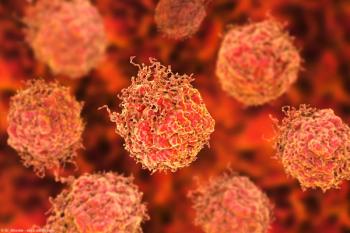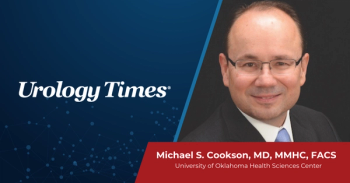
Genomic analysis identifies optimal mCRPC population for talazoparib
Tumors exhibiting homozygous DNA damage response (DDR) alterations were more likely to respond to talazoparib than those with heterozygous DDR alterations.
Among men with heavily pretreated metastatic castration-resistant prostate cancer (mCRPC), patients with germline and/or homozygous tumor DNA damage response (tDDR) alterations are most likely to respond to the PARP inhibitor talazoparib (Talzenna), according to a retrospective ad hoc exploratory subgroup analysis of the TALAPRO-1 trial presented during the 2021 American Association for Cancer Research (AACR) Virtual Annual Meeting.1
The open-label, international phase 2 TALAPRO-1 trial (NCT03148795) examined single-agent oral talazoparib at 1 mg daily in patients with mCRPC previously treated with taxane-based chemotherapy, as well as abiraterone acetate (Zytiga)/prednisone), enzalutamide (Xtandi), or both hormonal agents. All patients had at least 1 homologous recombination repair (HRR) gene alteration from a panel of 11 genes (HRR11) likely to sensitive their tumor to PARP inhibition: ATM, ATR, BRCA1, BRCA2, CHEK2, FANCA, MLH1, MRE11A, NBN, PALB2, RAD51C.
The data cutoff was September 4, 2020, and the primary end point was objective response rate (ORR) by blinded independent central review (BICR). The study met its primary end point as the final analysis showed that among 104 patients in the efficacy population, the ORR by BICR was 29.8% (n = 31).
“The strongest antitumor effect was observed in patients with BRCA alterations, with a confirmed ORR of 45.9% and a median radiographic progression-free survivalof 11.2 months,” said Johann de Bono, MB, ChB, FRCP, MSc, PhD, FMedSci, head of drug development at The Institute of Cancer Research, London, and The Royal Marsden NHS Foundation Trust.
Talazoparib also induced objective responses in patients with non-BRCA HRR gene alterations, including PALB2 and ATM alterations.
“Both the antitumor activity and tolerability was promising [with talazoparib] for this heavily pretreated population of mCRPC patients,” said de Bono.
Regarding the ad hoc analyses presented during the AACR meeting, de Bono said, “We explored the importance of germline versus somatic origin and the zygosity of these DNA repair defects [in association with] response.”
De Bono explained, “Characterization of alteration origin was based on a comparison of DNA sequences from matched tumor and saliva samples.” FoundationOne® was used to test tumor tissue and Ambry Genetics CustomNext-Cancer panel was used to test saliva. The somatic-germline-zygosity (SGZ) computational algorithm established by Sun et al2 was used to predict zygosity.
“Both the characterization of origin and zygosity prediction were limited to short variants. The analysis was focused on the HRR-altered measurable disease population, defined as patients who had measurable soft-tissue disease at screening and a DNA-repair gene defect presumed to directly or indirectly sensitize [the tumor] to PARP inhibition as assessed in the HRR11 core gene panel, and had received at least 1 dose of talazoparib,” said de Bono.
The assessment of tumor alterations by origin showed that 25 were germline, 43 were somatic, and 33 were unknown or not evaluable.
“BRCA2 and ATM were the most commonly altered genes. The BRCA2 alterations were evenly split between germline and somatic, at 13 versus 19, respectively. In contrast, the ATM alterations tended to be somatic in origin,” said de Bono.
Among 25 patients with germline alterations, the ORR was 28% (n = 7), comprising 1 CR and 6 PRs. An additional 10 patients had stable disease (SD), 6 patients had progressive disease (PD), and 2 patients were not evaluable.
The ORR was 25.6% (n = 11) among 43 patients with somatic mutations; this included 3 CRs and 8 PRs. Another 16 patients reached SD, 9 had PD, and 5 were not evaluable. Two other patients were categorized by the investigators as “non-CR/non-PD.”
“ORRs were similar for germline and somatic alterations,” said de Bono.
In the BRCA2 subpopulation, among 13 patients with germline BRCA2 alterations, the ORR was 53.8% (n = 7), comprising 1 CR and 6 PRs. An additional 5 patients had SD and 1 patient was not evaluable.
The ORR was 36.8% (n = 7) among 19 patients with somatic BRCA2 alterations; this included 2 CRs and 5 PRs. Another 6 patients reached SD, 2 patients had non-CR/non-PD, 2 patients had PD, and 2 patients were not evaluable.
“As expected, for the BRCA2-altered tumors we saw the highest ORR, independent of germline versus somatic origin,” said de Bono.
The assessment of the prevalence of tumor alterations by zygosity across all HRR11 alterations found that 30 were homozygous, 30 were heterozygous, and 13 were not evaluable.
Among 30 patients with homozygous alterations, the ORR was 40% (n = 12), comprising 3 CRs and 9 PRs. An additional 9 patients had SD, 2 patients had non-CR/non-PD, 6 patients had PD, and 1 patient was not evaluable.
The ORR was 13.3% (n = 4) among the 30 patients with heterozygous alterations; this included 1 CR and 3 PRs. Another 12 patients reached SD, 10 had PD, and 4 patient were not evaluable.
“The ORR was significantly higher for homozygous alterations. Interestingly, the short variants not evaluable for SGZ prediction (n = 32) exhibited an ORR (40.6%) similar to homozygous alterations, although the interpretation of these data are unclear,” said de Bono.
Regarding zygosity in the BRCA2 subgroup, alterations were primarily homozygous; there were 18 homozygous and 9 heterozygous alterations. This breakdown contrasted with some of the other variants, such as CHECK2, in which the alterations were mainly heterozygous.
In the 18-patient BRCA2 homozygous group, the ORR was 50% (n = 9), comprising 2 CRs and 7 PRs. An additional 5 patients had SD, 2 had non-CR/non-PD, 1 had PD, and 1 patient was not evaluable.
Among the 9 BRCA2 patients with heterozygous alterations, the ORR was 44.4% (n = 4), comprising 1 CR and 3 PRs. Another 2 patients reached SD, 1 had PD, and 2 patients were not evaluable.
“TheORR was higher for BRCA2 patients, independent of detectable zygosity. The difference in response by zygosity observed in the BRCA2 subset and the larger HRR panel does suggest a higher ORR for homozygous loss across the DNA repair genes and may reflect differences in zygosity distribution between the genes. For example, we saw 1 homozygous, 6 heterozygous, and 3 non-evaluable alterations for CHECK2,” explained de Bono.
Summarizing his discussion, de Bono said, “Based on this retrospective ad hoc exploratory analysis in this heavily pretreated mCRPC population, patients with diverse DDR alterations demonstrated responses to talazoparib monotherapy.
“Based on analysis of short variants, tumors exhibiting homozygous DDR alterations were more likely to respond to talazoparib than those with heterozygous DDR alterations. Potential explanations include gene-specific imbalances in zygosity of alterations and/or sensitivity to talazoparib, but further investigation in a larger data set is needed.”
References
1. de Bono JS, Laird AD, Mehra N, et al. TALAPRO-1 final data: Talazoparib (TALA) monotherapy in men with DNA damage response alterations (DDRalt) and metastatic castration-resistant prostate cancer (mCRPC)—exploration of DDRalt germline/somatic origin and zygosity. Presented at: 2021 AACR Virtual Annual Meeting Week 1; April 10-15, 2021. Abstract CT027.
2. Sun JX, He Y, Sanford E, et al. A computational approach to distinguish somatic vs. germline origin of genomic alterations from deep sequencing of cancer specimens without a matched normal. PLoS Comput Biol. 2018;14(2):e1005965. doi: 10.1371/journal.pcbi.1005965
Newsletter
Stay current with the latest urology news and practice-changing insights — sign up now for the essential updates every urologist needs.


















